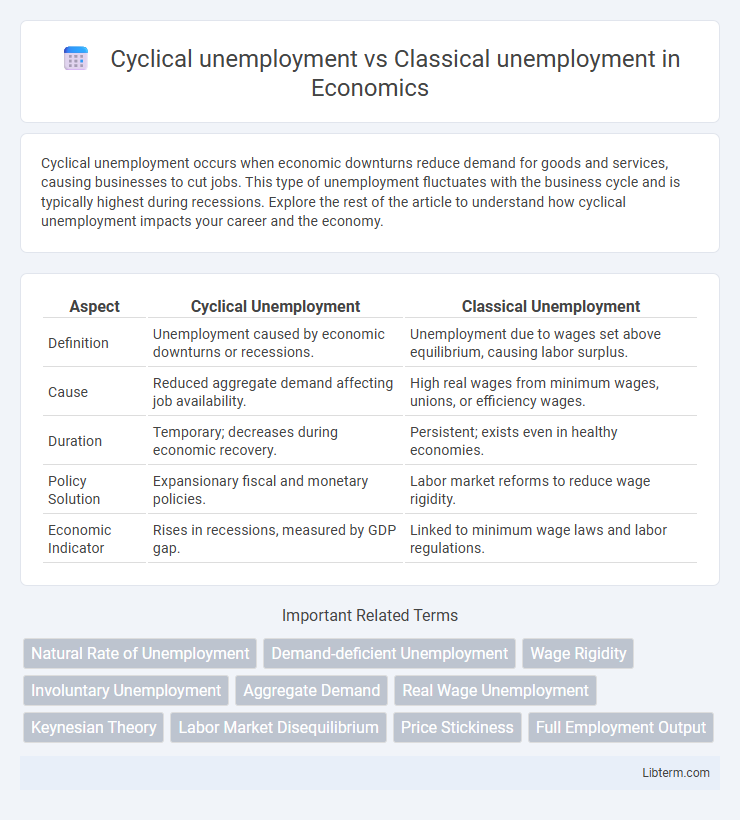Cyclical unemployment occurs when economic downturns reduce demand for goods and services, causing businesses to cut jobs. This type of unemployment fluctuates with the business cycle and is typically highest during recessions. Explore the rest of the article to understand how cyclical unemployment impacts your career and the economy.
Table of Comparison
| Aspect | Cyclical Unemployment | Classical Unemployment |
|---|---|---|
| Definition | Unemployment caused by economic downturns or recessions. | Unemployment due to wages set above equilibrium, causing labor surplus. |
| Cause | Reduced aggregate demand affecting job availability. | High real wages from minimum wages, unions, or efficiency wages. |
| Duration | Temporary; decreases during economic recovery. | Persistent; exists even in healthy economies. |
| Policy Solution | Expansionary fiscal and monetary policies. | Labor market reforms to reduce wage rigidity. |
| Economic Indicator | Rises in recessions, measured by GDP gap. | Linked to minimum wage laws and labor regulations. |
Understanding Unemployment: Key Definitions
Cyclical unemployment occurs due to fluctuations in the business cycle, rising during economic downturns when demand for goods and services declines. Classical unemployment arises from structural factors such as wage rigidity or minimum wage laws preventing labor market equilibrium, even when jobs are available. Understanding these distinctions is crucial for policymakers to design targeted interventions that address either demand-side issues or labor market inflexibilities.
What is Cyclical Unemployment?
Cyclical unemployment arises from fluctuations in the economic cycle, typically increasing during recessions when aggregate demand falls and businesses reduce hiring. It contrasts with classical unemployment, which occurs due to wage rigidities or labor market inefficiencies, independent of economic cycles. Understanding cyclical unemployment involves analyzing GDP growth rates, unemployment rates during downturns, and fiscal or monetary policy responses to stabilize the economy.
What is Classical Unemployment?
Classical unemployment occurs when wages are set above the market-clearing level, leading to a surplus of labor and joblessness despite available positions. It often results from minimum wage laws, labor unions, or other regulations that prevent wages from adjusting downward. This type of unemployment contrasts with cyclical unemployment, which is driven by fluctuations in economic demand and recessions.
Causes of Cyclical Unemployment
Cyclical unemployment arises from fluctuations in the business cycle, specifically during economic downturns when aggregate demand falls, leading to a decrease in production and labor demand. Key causes include reduced consumer spending, lower investment by firms, and contractionary fiscal or monetary policies that reduce overall economic activity. Unlike classical unemployment caused by wage rigidity and labor market mismatches, cyclical unemployment directly reflects deficiencies in total demand within the economy.
Causes of Classical Unemployment
Classical unemployment arises primarily from wage rigidity, where wages remain above the market-clearing level due to minimum wage laws, labor unions, or efficiency wages, causing excess labor supply. This type of unemployment occurs even when the economy is at full capacity, as high real wages discourage employers from hiring additional workers. Unlike cyclical unemployment, which results from downturns in economic activity, classical unemployment stems from structural factors that prevent wages from adjusting to equilibrium.
Economic Impact: Cyclical vs Classical Unemployment
Cyclical unemployment significantly reduces overall economic growth as it is directly linked to fluctuations in the business cycle, leading to decreased consumer spending and lower aggregate demand during recessions. Classical unemployment results from wage rigidities and labor market imperfections, causing a mismatch between wages and available jobs, which can lead to persistent inefficiencies in labor allocation. The economic impact of cyclical unemployment is typically temporary and macroeconomic-driven, while classical unemployment reflects structural issues requiring labor market reforms to restore full employment.
Policy Responses to Cyclical Unemployment
Policy responses to cyclical unemployment primarily involve expansionary fiscal and monetary policies, such as increased government spending, tax cuts, and lower interest rates, aimed at stimulating aggregate demand. Central banks may implement quantitative easing to boost liquidity and encourage borrowing, while governments often invest in infrastructure projects to create jobs and reduce unemployment during economic downturns. Unlike classical unemployment, which requires labor market reforms to address wage rigidities and improve supply-side factors, cyclical unemployment demands counter-cyclical interventions to stabilize economic fluctuations.
Policy Responses to Classical Unemployment
Policy responses to classical unemployment focus on improving labor market flexibility by reducing real wages through wage subsidies, tax cuts on labor, or deregulating employment standards to lower the cost of hiring. Supply-side policies such as training programs and enhancing worker mobility also address structural mismatches preventing equilibrium in the labor market. Unlike cyclical unemployment, classical unemployment requires interventions that directly adjust labor market conditions rather than demand stimulation.
Key Differences Between Cyclical and Classical Unemployment
Cyclical unemployment arises from fluctuations in the business cycle, typically increasing during economic recessions when demand for goods and services declines, causing widespread job losses. Classical unemployment results from structural factors such as wage rigidity, minimum wage laws, or labor market regulations that prevent wages from adjusting to clear the labor market, leading to persistent joblessness even in a growing economy. The key difference lies in their causes: cyclical unemployment is demand-driven and temporary, while classical unemployment stems from supply-side rigidities and wage-setting mechanisms.
Real-World Examples and Case Studies
Cyclical unemployment rises during economic downturns, illustrated by the 2008 global financial crisis when industries like automotive and construction shed millions of jobs worldwide, especially in the US and Europe. Classical unemployment occurs due to wage rigidities and labor market inefficiencies, exemplified by France's persistent unemployment despite economic growth, driven by high minimum wages and strong labor protections. These cases reveal how cyclical unemployment responds to demand shocks, while classical unemployment stems from structural factors limiting job creation.
Cyclical unemployment Infographic

 libterm.com
libterm.com